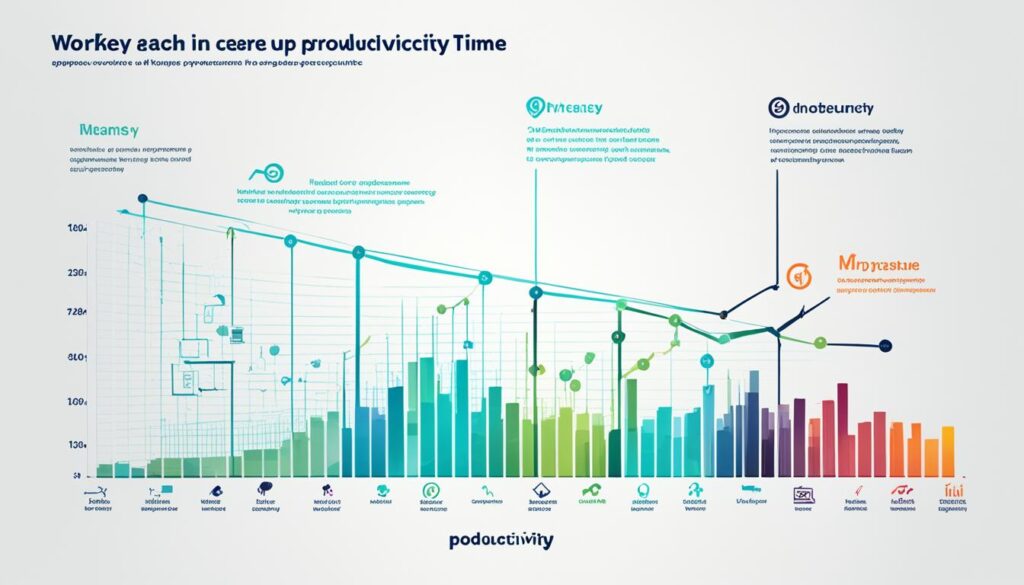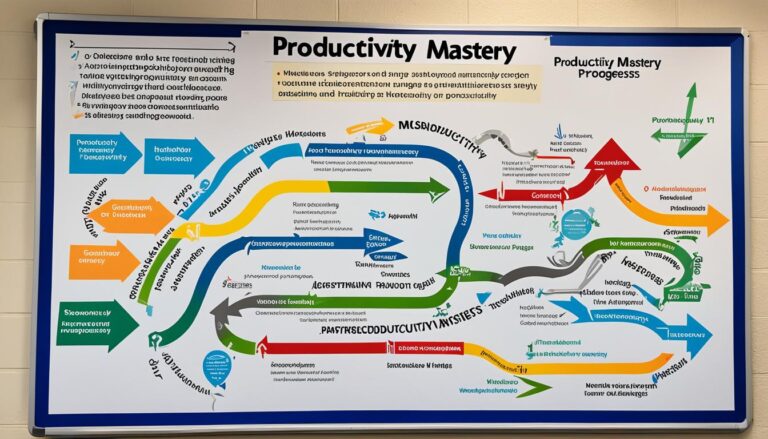Boost Your Success with Productivity Measurement

Have you ever wondered how to unlock your full potential and achieve greater success in your personal and professional life? The answer lies in productivity measurement. Many of us believe that simply working harder or longer hours will lead to success, but is that really the case? What if there was a way to work smarter instead of harder? What if there was a way to maximize your efficiency and achieve more with less effort?
In this article, we will explore the importance of productivity measurement and how it can significantly impact your success. We will delve into strategies to boost efficiency and employee engagement, as well as uncover tips to improve your personal productivity. Get ready to unlock your potential and take your success to new heights!
Key Takeaways:
- Productivity measurement is crucial for unlocking your full potential and achieving greater success.
- Working smarter, not harder, is the key to maximizing efficiency and achieving more with less effort.
- Measuring productivity can reveal areas for improvement and help you make data-driven decisions.
- Boosting employee engagement and improving personal productivity are essential for overall success.
- Implementing strategies to increase efficiency and productivity can lead to a more successful and fulfilling life.
What is Productivity in the Workplace?
Productivity in the workplace refers to how effectively employees use their time, resources, and talent to produce results. It is a measure of efficiency and effectiveness in completing tasks and achieving goals. By measuring productivity, organizations can evaluate performance, identify areas for improvement, and make data-driven decisions to enhance overall business productivity.
Measuring productivity is crucial in today’s remote work environment to ensure that employees remain focused, motivated, and engaged. It helps businesses track progress, identify bottlenecks, and allocate resources effectively. By understanding what tasks employees find challenging or time-consuming, organizations can optimize workflows and provide appropriate support to enhance productivity.
When employees are working remotely, it becomes essential to measure productivity accurately. By implementing productivity measurement tools and strategies, businesses can maintain visibility into employee performance and ensure that work is being completed efficiently. This not only boosts productivity but also promotes a healthy work-life balance and prevents burnout.
Effective productivity measurement involves tracking key performance indicators (KPIs), analyzing productivity metrics, and conducting regular performance evaluations. By monitoring individual and team productivity levels, businesses can identify top-performing employees, address performance gaps, and provide targeted training and development opportunities.
Benefits of Measuring Workplace Productivity
- Identify areas for improvement and implement productivity-enhancing strategies.
- Evaluate the effectiveness of existing practices and make data-driven decisions.
- Optimize resource allocation and reduce inefficiencies.
- Enhance employee engagement, morale, and job satisfaction.
- Improve overall business performance, profitability, and competitiveness.

| Workforce Productivity Metrics | Description |
|---|---|
| Output per hour | Measures the amount of output generated per hour of work. |
| Employee Utilization Rate | Calculates the percentage of time an employee spends on productive work tasks. |
| Employee Satisfaction and Engagement | Assesses the level of employee satisfaction, motivation, and engagement. |
| Revenue per Employee | Calculates the revenue generated per employee, indicating their individual contribution to the organization’s financial performance. |
By regularly measuring and analyzing productivity metrics, businesses can identify patterns, spot trends, and implement strategies to improve workforce productivity. It allows organizations to make informed decisions, allocate resources effectively, and create a culture of productivity and continuous improvement.
Why Must You Measure Employee Productivity?
Measuring productivity is essential for any organization that wants to maximize its potential. It offers numerous benefits that can positively impact your business and workforce.
Improved engagement and morale: When employees see the fruits of their labor and understand how their work contributes to the overall success of the company, it boosts their motivation and satisfaction. By measuring productivity, you can identify and acknowledge high-performing individuals or teams, creating a culture of recognition and positivity.
Identifying areas for improvement: Productivity measurement helps pinpoint inefficiencies and areas that require attention. By evaluating individual and team performance, you can identify bottlenecks, ineffective procedures, or inadequate resources. This insight allows you to implement targeted improvements and optimize your processes, leading to increased efficiency and effectiveness.
Making smarter decisions: Accurate and reliable data on employee productivity guides informed decision-making. It enables you to identify high-performing individuals and teams for potential leadership positions, allocate resources effectively, and streamline workflow. Furthermore, by understanding how productivity influences your bottom line, you can make strategic choices that optimize your business’s financial performance.
Evaluating the effectiveness of strategies and practices: Measuring productivity provides a quantitative assessment of the strategies and practices implemented within your organization. By analyzing the impact on productivity levels, you can identify which approaches are most effective and make data-driven decisions moving forward.
Cost savings from better resource allocation: Productivity measurement allows you to identify resource inefficiencies and allocate them more effectively. By understanding where resources are being underutilized or wasted, you can reallocate them to areas that require greater support, reducing unnecessary costs and optimizing your budget.
Increased profitability: Ultimately, measuring employee productivity directly impacts your business’s profitability. By optimizing performance, streamlining processes, and allocating resources effectively, you can achieve higher output, increased revenue, and improved overall financial performance.
| Benefits of Measuring Employee Productivity |
|---|
| Improved engagement and morale |
| Identifying areas for improvement |
| Making smarter decisions |
| Evaluating the effectiveness of strategies and practices |
| Cost savings from better resource allocation |
| Increased profitability |

By measuring productivity, you can also evaluate the impact of training programs and customize them for better results, ensuring that your workforce is equipped with the necessary skills and knowledge to excel.
Now that we understand the importance of measuring employee productivity, let’s explore how you can effectively measure it in the next section.
How to Measure Employee Productivity
To effectively measure employee productivity, it is crucial to establish clear productivity standards and track individual performance. By emphasizing quality, using appropriate tracking tools, reassessing metrics regularly, and aligning key performance indicators with business goals, organizations can gather valuable data on tasks, time spent, and output. This data-driven approach enables businesses to gain insights into workforce productivity and make informed decisions to drive efficiency and effectiveness.
Establish Productivity Standards
Start by defining productivity standards that are specific, measurable, achievable, relevant, and time-bound (SMART). These standards form the basis for evaluating employee performance and setting benchmarks for improvement.
Track Individual Performance
Monitoring individual performance allows for a deeper understanding of employees’ strengths, weaknesses, and productivity levels. This can be achieved through regular performance reviews, feedback sessions, and performance management systems.
Emphasize Quality
Measuring productivity goes beyond output quantity alone. Emphasize the importance of delivering high-quality work and achieving desired outcomes to ensure that productivity metrics reflect both quantity and quality.
Use Tracking Tools
Utilize digital tools and software that enable accurate tracking of tasks, time spent, and progress towards goals. These tools provide real-time data to measure individual and team productivity effectively.
Reassess Metrics Regularly
Periodically review and reassess the productivity metrics being used. Adjust them as needed to reflect changing business requirements, industry trends, and individual circumstances to ensure relevance and accuracy.
Align Indicators with Business Goals
Productivity metrics should align with broader business goals and objectives. Ensure that the chosen key performance indicators (KPIs) directly contribute to the organization’s success and drive productivity in areas that matter most.

Recommended Productivity Metrics for Employee Measurement
| Metric | Description |
|---|---|
| Output Quantity | The quantity of work completed within a defined time period. |
| Output Quality | The level of accuracy, attention to detail, and adherence to standards in completed work. |
| Task Completion Time | The amount of time taken to complete specific tasks or projects. |
| Adherence to Deadlines | The ability to consistently meet project deadlines and deliver work on time. |
| Efficiency | The ability to achieve desired outcomes with minimal resources and effort. |
| Attendance and Punctuality | The regularity and punctuality in attending work and meetings. |
By implementing these strategies and utilizing appropriate metrics, organizations can measure and improve employee productivity effectively. This data-driven approach enables informed decision-making, continuous improvement, and the attainment of business objectives.
How to Increase Employee Productivity
To achieve optimal productivity levels in your workforce, it is essential to implement effective strategies that empower your employees to perform at their best. By creating a baseline, providing support and resources, minimizing distractions, and utilizing automation tools, you can significantly enhance overall productivity.
1. Create a Baseline
Before embarking on any productivity improvement initiatives, establish a baseline to measure progress accurately. Analyze current productivity levels and identify areas for improvement. This will allow you to set realistic goals and track your progress effectively.
2. Provide Support and Resources
Equip your employees with the necessary resources, such as training, tools, and technologies, to perform their tasks efficiently. Additionally, offer ongoing support through mentorship programs or regular check-ins to address any challenges they may face.
3. Minimize Distractions
Distractions can significantly impact productivity. Encourage your employees to prioritize their work and create a distraction-free environment. Implement policies that limit non-work-related activities and foster a focused work atmosphere.
4. Utilize Automation Tools
Automating repetitive tasks can save time and improve efficiency. Identify areas that can benefit from automation, such as data entry or report generation, and invest in suitable tools or software. This allows your employees to focus on more valuable, high-impact tasks.
5. Optimize Workflow
Analyze your existing processes and streamline them to eliminate bottlenecks and inefficiencies. Encourage collaboration and communication among team members to ensure smooth workflow and effective task coordination.
6. Set Deadlines
Clear and realistic deadlines help employees prioritize their tasks and maintain a sense of urgency. Establish SMART (Specific, Measurable, Achievable, Relevant, and Time-Bound) goals and communicate them effectively to ensure clarity and accountability.
7. Maintain a Task Timesheet
Encourage employees to track and record their time spent on each task using a task timesheet. This helps identify time-consuming activities and provides insights for optimizing workflow and resource allocation.
8. Recognize and Reward Good Performance
Create a culture of recognition and appreciation by acknowledging and rewarding employees for their outstanding performance. This fosters motivation, engagement, and a sense of accomplishment, ultimately boosting productivity.

Implementing these strategies will drive productivity improvement in your workforce. By empowering your employees and creating an environment conducive to productivity, you can enhance overall performance and achieve optimal results.
Conclusion
Productivity measurement plays a vital role in the success and growth of businesses. By effectively measuring and tracking workplace productivity, organizations can empower their employees, identify areas for improvement, and make data-driven decisions to drive profitability. Embracing strategies to enhance efficiency and personal productivity sets the stage for a more streamlined and prosperous business.
Measuring efficiency allows businesses to understand how effectively their workforce utilizes time and resources to achieve desired outcomes. It enables organizations to identify and address potential bottlenecks or challenges, ensuring optimal performance. By implementing productivity improvement measures, such as setting clear goals and using key performance indicators, businesses can elevate their productivity metrics and achieve greater success.
Improving productivity not only benefits the business but also enhances employee engagement and satisfaction. This, in turn, fosters a positive work culture where employees feel valued, motivated, and empowered to excel in their roles. Ultimately, a focus on productivity measurement, efficiency, and improvement drives success by unlocking the full potential of both the organization and its employees.






